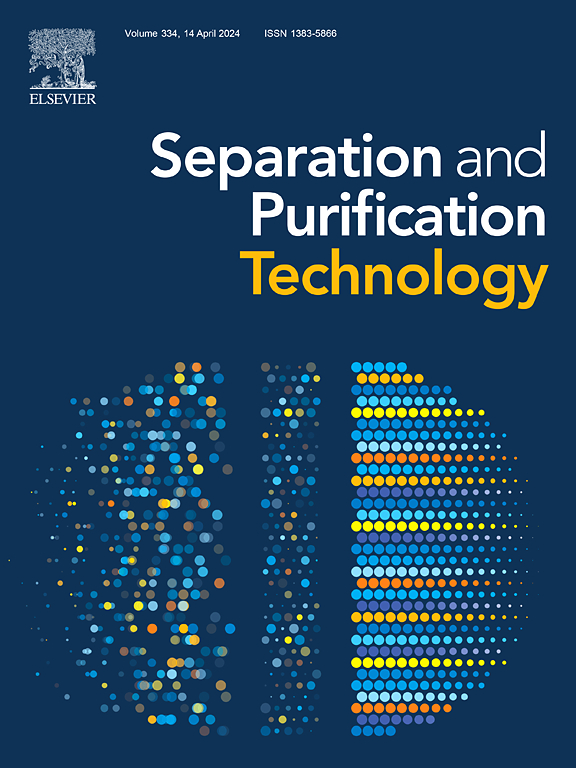Microwave-assisted synthesis of three dimensional superhydrophilicity ion imprinted polymer based on POSS/SBA-15 for copper ion adsorption in environmental water
IF 9
1区 工程技术
Q1 ENGINEERING, CHEMICAL
引用次数: 0
Abstract
The research developed a three-dimensional super-hydrophilic Cu(II)-imprinted polymer(Cu(II)-IIP) utilizing Polyhedral oligomeric silsesquioxane(POSS) and Santa Barbara Amorphous-15(SBA-15) as the matrix material, in conjunction with surface imprinting and microwave-assisted techniques. SBA-15 improved the dispersion of the three-dimensional cage-like POSS structure, thus facilitating a more uniform distribution of imprinting sites. Microwave-induced polymerization markedly decreases the reaction duration to about 60 min-one-sixth of the time needed for traditional heat-induced techniques-highlighting its good efficiency and the time-saving benefits of microwave-assisted synthesis in polymer fabrication. The Cu(II)-IIP based on POSS/SBA-15 composite achieved a maximum adsorption capacity of 163.87 mg/g within 60 min under optimal conditions (pH 5, adsorbent dosage of 0.5 g/L, and a POSS mass fraction of 52.94 %), which was almost four times greater than that of the non-ion-imprinted polymer (NIIP), which only showed an adsorption capacity of 41.99 mg/g, the result was further analyzed using Langmuir isotherms and Pseudo-second order kinetics. The Cu(II)-IIP exhibited excellent adsorption–desorption efficacy during five successive cycles, with stable repeatability measurements, signifying remarkable stability and reusability of the material. The Cu(II)-IIP demonstrates significant selectivity for Cu(II) at pH 5.0, attributed to the development of specific recognition sites that correspond to the size and coordination environment of Cu(II). Additionally, the elevated surface area and mesoporous structure of SBA-15 improve ion accessibility in both binary and multi-component systems. The synthesized Cu(II)-IIP demonstrated effective application for analyzing two distinct concentrations (25.0 and 50.0 µg/L) in Yudai River and Yangtze River water, achieving satisfactory recoveries between 97.90 % and 103.24 %. Density functional theory and frontier molecular orbital calculations indicate that the adsorption of Cu(II) in Cu(II)-IIP is primarily due to the coordination between the nitrogen atom on 4-VP and Cu(II).
微波辅助合成基于POSS/SBA-15的三维超亲水性离子印迹聚合物对环境水中铜离子的吸附
该研究利用多面体低聚硅氧烷(POSS)和Santa Barbara amorphus -15(SBA-15)作为基体材料,结合表面印迹和微波辅助技术,开发了一种三维超亲水性Cu(II)-印迹聚合物(Cu(II)-IIP)。SBA-15提高了三维笼状POSS结构的分散性,使得印迹位点分布更加均匀。微波诱导聚合的反应时间明显缩短至约60 min-传统热诱导聚合技术所需时间的六分之一-突出了微波辅助合成在聚合物制造中的良好效率和节省时间的优势。在最佳条件下(pH 5,吸附剂用量为0.5 g/L, POSS质量分数为52.94 %),基于POSS/SBA-15复合材料的Cu(II)-IIP在60 min内获得了163.87 mg/g的最大吸附量,几乎是非离子印迹聚合物(NIIP)的4倍,NIIP的吸附量仅为41.99 mg/g,进一步采用Langmuir等温度和拟二级动力学分析结果。Cu(II)-IIP在连续5个循环中表现出优异的吸附-解吸效果,具有稳定的重复性测量,表明材料具有良好的稳定性和可重复使用性。Cu(II)-IIP在pH 5.0下对Cu(II)表现出显著的选择性,这是由于Cu(II)的大小和配位环境对应的特异性识别位点的发展。此外,SBA-15的高表面积和介孔结构提高了离子在二元和多组分体系中的可及性。所合成的Cu(II)-IIP可有效地用于分析玉带河和长江中25.0和50.0 μ g/L浓度的Cu(II)-IIP,回收率为97.90 % ~ 103.24 %。密度泛函理论和前沿分子轨道计算表明,Cu(II)在Cu(II)-IIP中的吸附主要是由于4-VP上的氮原子与Cu(II)之间的配位作用。
本文章由计算机程序翻译,如有差异,请以英文原文为准。
求助全文
约1分钟内获得全文
求助全文
来源期刊

Separation and Purification Technology
工程技术-工程:化工
CiteScore
14.00
自引率
12.80%
发文量
2347
审稿时长
43 days
期刊介绍:
Separation and Purification Technology is a premier journal committed to sharing innovative methods for separation and purification in chemical and environmental engineering, encompassing both homogeneous solutions and heterogeneous mixtures. Our scope includes the separation and/or purification of liquids, vapors, and gases, as well as carbon capture and separation techniques. However, it's important to note that methods solely intended for analytical purposes are not within the scope of the journal. Additionally, disciplines such as soil science, polymer science, and metallurgy fall outside the purview of Separation and Purification Technology. Join us in advancing the field of separation and purification methods for sustainable solutions in chemical and environmental engineering.
 求助内容:
求助内容: 应助结果提醒方式:
应助结果提醒方式:


